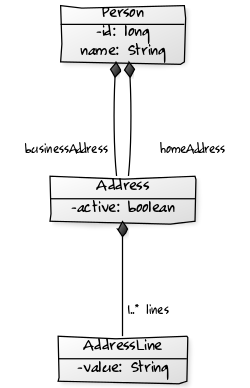The other day I came across an interesting mapping challenge which I thought may be worth sharing. If you are a seasoned JPA user, it will probably be nothing new to you, but those not as experienced may find it helpful :)
TL;DR - JPA let’s you override database columns for embedded objects but also for collections of embedded objects; @AttributeOverride and @AssocationOverride can be used for that.
Let’s assume the following entity model representing a person and their home and business address:

The interesting part is that Person has two associations with Address, one with the "homeAddress" role and another one with the "businessAddress" role. Address in turn has one ore more address lines.
When mapping these types with JPA, Person naturally becomes an entity. As there is a composition relationship between Person and Address, the latter is mapped with @Embeddable. The same goes for AddressLine, which also is an @Embeddable, contained within an element collection owned by Address.
So you’d end up with these classes:
@Entity
public class Person {
@Id
private long id;
private String name;
private Address homeAddress;
private Address businessAddress;
// constructor, getters and setters...
}@Embeddable
public class Address {
private boolean active;
@ElementCollection
private List<AddressLine> lines = new ArrayList<AddressLine>();
// constructor, getters and setters...
}@Embeddable
public class AddressLine {
private String value;
// constructor, getters and setters...
}@AttributeOverride
Let’s fire up a session factory with these types (this uses the brand-new bootstrapping API coming in Hibernate ORM 5) and see how that goes:
StandardServiceRegistry registry = new StandardServiceRegistryBuilder()
.applySetting( AvailableSettings.SHOW_SQL, true )
.applySetting( AvailableSettings.FORMAT_SQL, true )
.applySetting( AvailableSettings.HBM2DDL_AUTO, "create-drop" )
.build();
SessionFactory sessionFactory = new MetadataSources( registry )
.addAnnotatedClass( Person.class )
.buildMetadata()
.buildSessionFactory();Hum, that did not go too well:
org.hibernate.MappingException: Repeated column in mapping for entity:
org.hibernate.bugs.Person column: active (should be mapped with insert="false" update="false")Of course this makes sense; As Address is embedded twice within Person, its properties must be mapped to unique column names within the Person table. The @AttributeOverride annotation can be used for that:
@Entity
public class Person {
@Id
private long id;
private String name;
@AttributeOverride(name = "active", column = @Column(name = "home_address_active"))
private Address homeAddress;
@AttributeOverride(name = "active", column = @Column(name = "business_address_active"))
private Address businessAddress;
// constructor, getters and setters...
}With that, the session factory boots successfully. But let’s take a look at the tables that get created:
create table Person (
id bigint not null,
business_address_active boolean,
home_address_active boolean,
name varchar(255),
primary key (id)
)
create table Person_lines (
Person_id bigint not null,
"value" varchar(255)
)@AssociationOverride
The Person table looks alright, but there is only a single table for the address lines. That’s a problem as it means there is no way to tell apart the lines of the business address from the lines of the home address when reading back a person from the database.
So what to do? @AttributeOverride is of no help this time, as it’s not a single column which needs to be re-defined but an entire table. But luckily, @AttributeOverride has a companion, @AssociationOverride. This annotation can be used to configure the required tables in this case:
@Entity
public class Person {
@Id
private long id;
private String name;
@AttributeOverride(name = "active", column = @Column(name = "home_address_active"))
@AssociationOverride(name = "lines", joinTable = @JoinTable(name = "Person_HomeAddress_Line"))
private Address homeAddress;
@AttributeOverride(name = "active", column = @Column(name = "business_address_active"))
@AssociationOverride(name = "lines", joinTable = @JoinTable(name = "Person_BusinessAddress_Line"))
private Address businessAddress;
// constructor, getters and setters...
}Et voilà, now you’ll get the DDL for creating the Person table and two different tables for the address lines:
create table Person (
id bigint not null,
business_address_active boolean,
home_address_active boolean,
name varchar(255),
primary key (id)
)
create table Person_BusinessAddress_Line (
Person_id bigint not null,
"value" varchar(255)
)
create table Person_HomeAddress_Line (
Person_id bigint not null,
"value" varchar(255)
)
